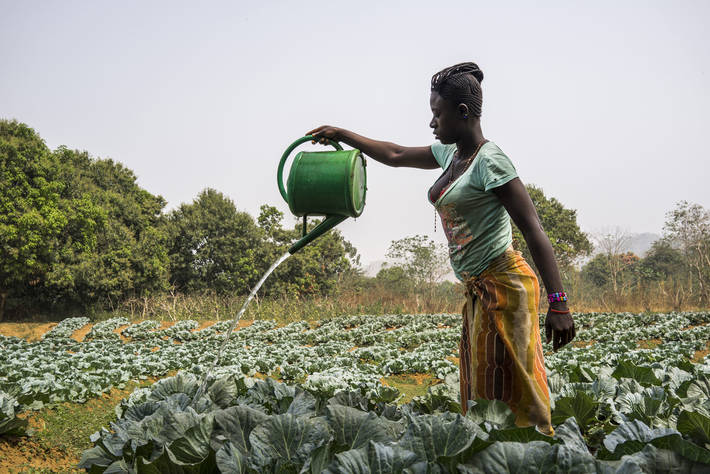Aside from domestic use, water is essential in industry, particularly in agriculture. Water scarcity or variability in water availability impacts farming in different ways, from delaying farming operations to causing crop failure. For many, farming is part of their livelihood, but on a more national scale, it is an important economic sector, employing over 50% of the African population. Although women represent approximately 50% of the labour force in this sector, they are restricted by cultural and societal expectations. Despite the energy and time that women invest in agriculture, their output and yield remain lower compared to males. This is due to a variety of factors, including access to land and labour, as well as challenges related to time poverty, to name a few.
Cultural norms:
It is interesting to further dissect these gendered roles in terms of agriculture, as men and women have different responsibilities on the farm. The distinction is often made based on the physical strength required. For instance, men are accountable for the success of the farm by performing jobs that are usually physically demanding or laborious. Women, however, are responsible for water collection, sowing of seeds on cultivated fields, harvesting, processing, and marketing of farm products.
Land rights:
These cultural norms, in combination with legal conditions, can prevent or restrict women from owning property. Therefore, women not only have limited access and control over land but in cases where they do own the land, it is often smaller (between 20 and 70% less than men) or of lower quality, This affects their ability to irrigate the land for domestic or economic purposes. Although this limits productivity and output, it also impacts women’s welfare and empowerment. Past this, land rights are linked to water rights as the groundwater found beneath a plot of land can be accessed and used by the person who owns it. In cases where women, particularly those who are the heads of households, are often given small plots of land furthest from the water source. Therefore, this creates a cycle in which land rights and food security are intertwined. Additionally, it is important to understand the role of technology in agriculture as the ease of farming is improved through capital investment, which is not always an option for female-owned farms as income is limited and technology can be harder to use. The choice of irrigation technology depends on land ownership, water source, land size, and the financial capacity of the individual.
The Millennium Development Goals recognise the need to promote gender equality to alleviate poverty and this can be done by addressing the inequalities within agriculture. The African Union gender equality commitments focus on achieving 30% documented land ownership for women. Setting targets is a start, but a plan needs to be implemented for this to be realistic and obtainable. When will these need to be achieved? How will progress be monitored and who will be accountable? Different policies must be used for different countries and communities to ensure that they are effective and efficient in supporting women. For solutions to be effective, they must consider the constraints that women face, such as time poverty. Women tend to have less uncommitted time than men leaving little time to participate in other things, such as programmes. Therefore, programmes need to be flexible to ensure that they are accessible and convenient for many.
Issues regarding women’s land ownership are both global and specific to Africa and so are complex to address. Therefore, solutions need to focus on the broader agricultural sector and consider aspects like participation rather than specifically focusing on increasing land ownership. One proposition would be to create programmes that focus on supporting women to maximise the land they have access to, through financing options such as loans. In the long term, governments should focus more on improving legal frameworks to ensure that women are accounted for and are not restricted.

Hi Anda, you raised some relevant points about why women’s land access and ownership is limited. Is there a current example where legal frameworks or incentives have been implemented, and have been successful in facilitating women’s land ownership / ensuring their rights have been accounted for? Looking forward to your response!
ReplyDeleteHi Greta, thank you for your question! The more I have looked into legal frameworks the more I have recognised the role of culture and societal norms. For instance, the Ethiopian government introduced land title certification in 2003 which allowed joint land ownership including women and spouses. Although this legal right has existed for many years, customary practices and stereotypes remain prevalent in the country meaning that this legal right is underutilised. Therefore, simply introducing new laws is not enough as they do not account for local customs. This is where participation becomes valuable as locals, particularly women, can be made aware of their rights and also informed on what these rights mean. In doing so, this should support women in being heard and educated so they can make the right choices.
DeleteHi ! I found your post really interesting and detailed ! I really enjoyed reading about the differences in land rights but also the need for programmes to adapt to women’s times ! Really looking forward for your next posts !!
ReplyDeleteHi Camille, thank you for taking the time to read my post. I am glad you have liked it. My next post about toilets and sanitation is now up, I hope you like reading that one too - please do let me know if you have any comments or feedback!
Delete